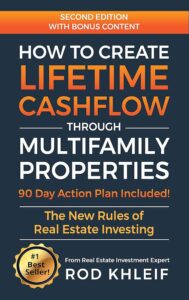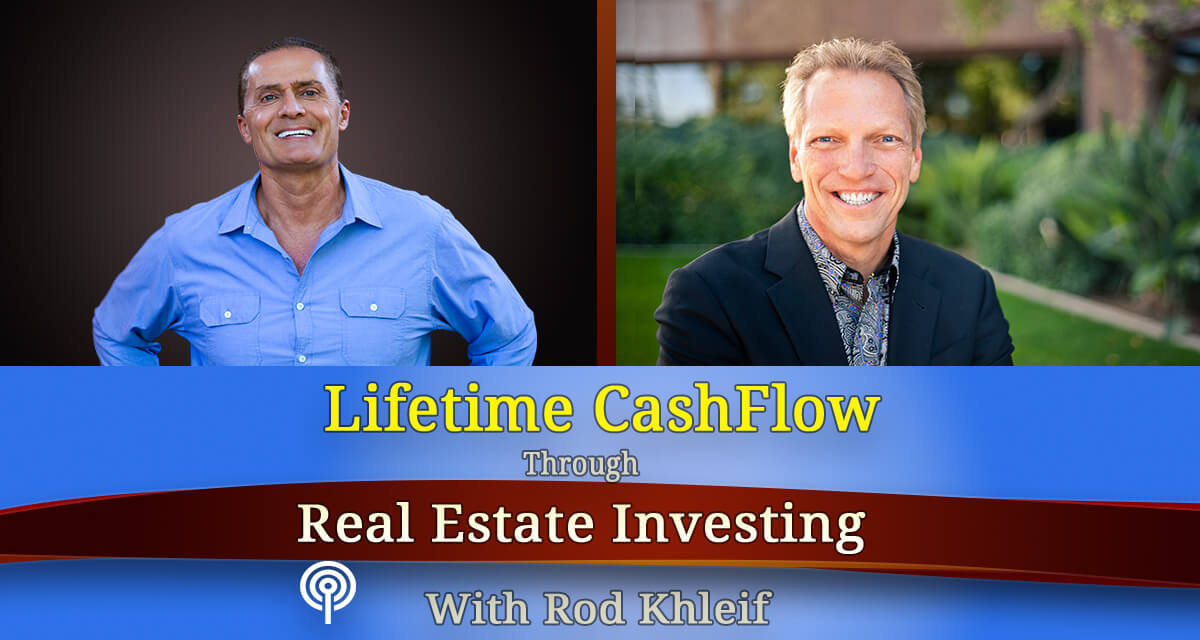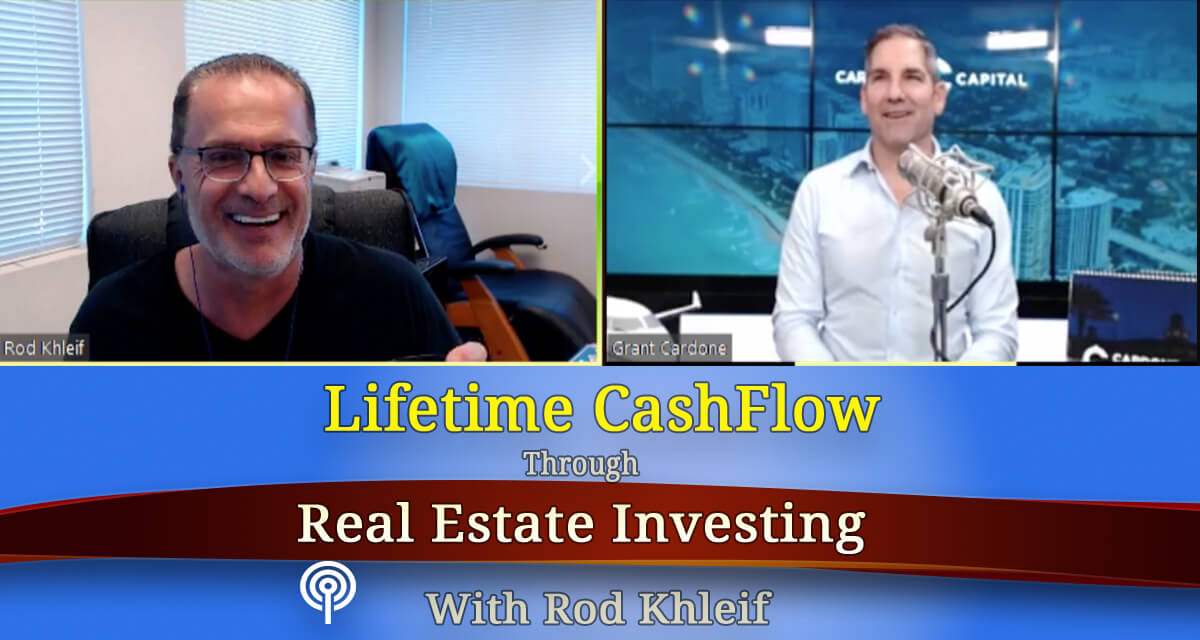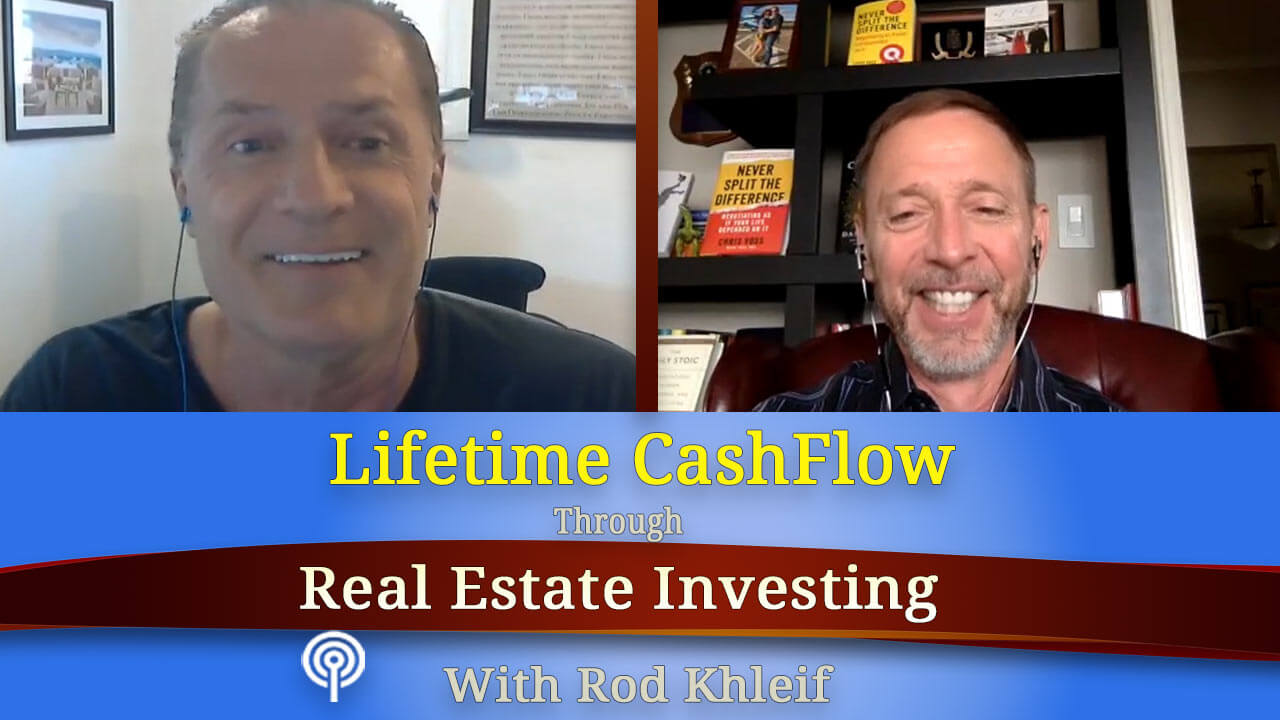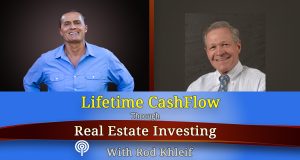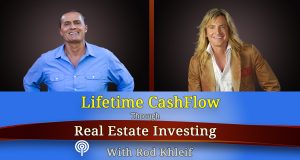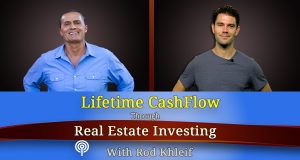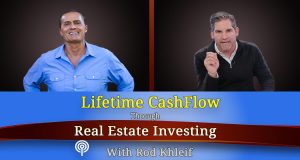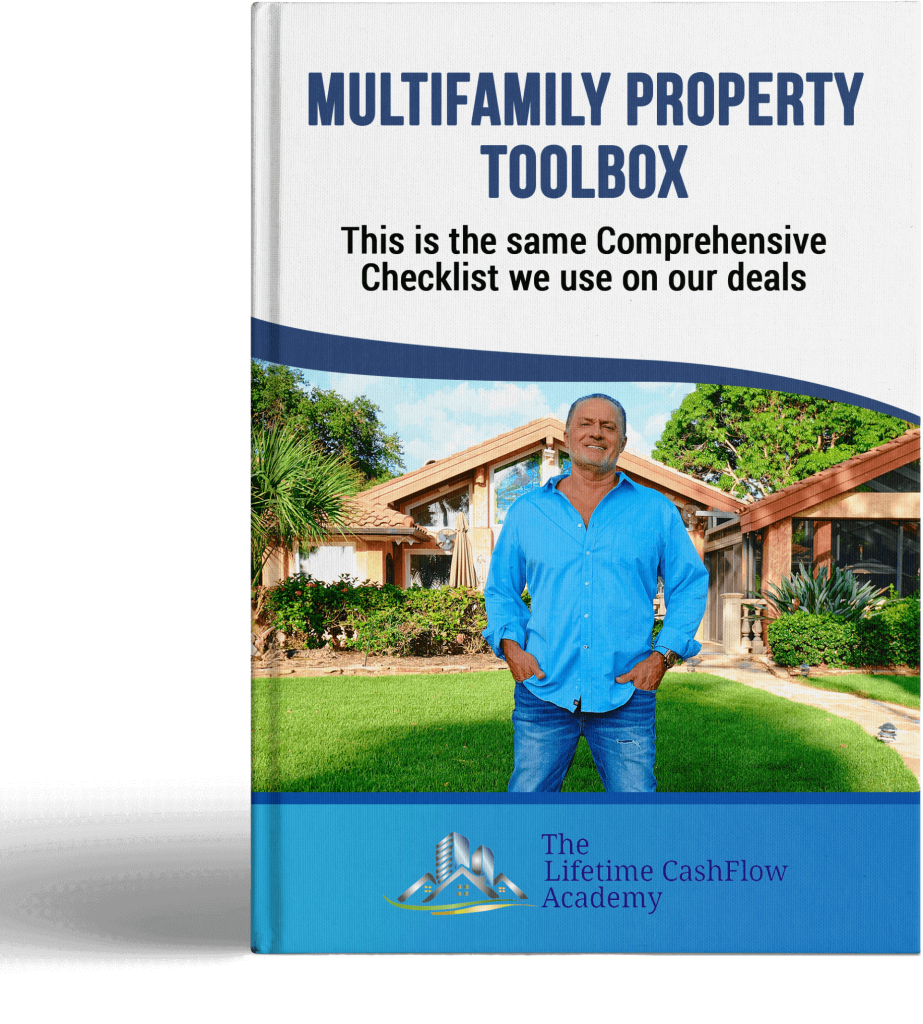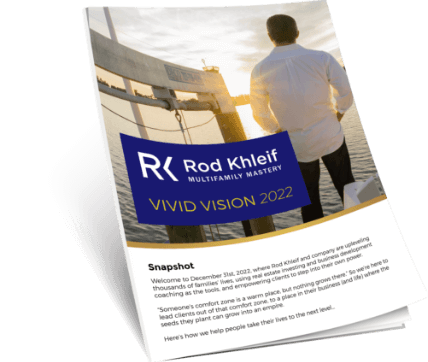Ep #367 – John Martinez – Secrets of a Master Real Estate Salesman
Here is some of what you will learn:
Can you read your customer’s mind?
How to Identify: Problem, Impact, Picture Perfect
How to relieve pressure
Reversing the “not OK” feelings
The two important areas of any sales conversation
Understanding your prospect’s motivation
Dealing with deal killers
Go for NO
Seeing into the future
Why you should nix the assumptive close
The importance of price anchoring
To find out more about our guest: click here
Full Transcript Below:
John Martinez – How to Become a Master Real Estate Salesperson (Ep367)
Hi! I’m Rod Khleif. Each and every week I record an interview with a thought leader that I know you’re gonna get a ton of value from. Now here on YouTube are the video versions of my podcast, Lifetime Cash Flow through Real Estate Investing. Now to make sure you get the latest information please subscribe and hit the notification bell. Let’s get started.
Rod: Welcome to another edition of How to Build Lifetime Cash Flow through real estate investing. I’m Rod Khleif and I’m thrilled you’re here. I know you’re gonna get incredible value from the dynamic gentleman we’re interviewing today. His name is John Martinez. His company is Midwest Revenue Group and John is a sales expert. He’s a sales training expert and I wanted to have him on the show because in life you are selling, I don’t care if you’re with your children you’re selling, with your spouse you’re selling but definitely in the multifamily real estate game you are selling yourself: you’re selling yourself to sellers, to brokers, to potential investors and on and on, and so you need sales strategy. In fact, one of the books I give my coaching students is a sales book because it’s so critical to understand and master sales. So John, welcome brother I’m glad you’re here.
John: Yeah, glad to be here. Thank you.
Rod: Yeah, my pleasure. So maybe, you know, I know that you’ve been in the some form of sales training for 20 years and I think reading your bio you’ve started focusing on specifically real estate sales training four years ago and before we started recording we talked about, you know, a mastermind that I’m gonna go participate in collective genius which has probably some of the top real estate flippers and wholesalers on the planet, really, and I’m going because I really know they do a masterful job with their mastermind and I’m really interested in enhancing my mastermind so that’s one of the reasons I’m going but I’m excited to go, but I know you work with a lot of those guys. So, you know, let’s talk about, you know, maybe how you got into, why you decided real estate and then let’s dig into some strategy.
John: Yeah, yeah. So really I didn’t cite real estate. Real estate kind of chose me. I’ve trained in probably about 50 industries today from IT to manufacturing and so on and by accident I was training at a call center once I produced leads for agents and investors and they got a hold of one of their investors trying to sell some leads he said what’s change and he said there’s no sales trainer in here coaching us. Anyways I got connected and he was in collective genius, he still is. His name is Will Denker out of Houston. Will was like, hey, come on down to Houston, train my team. I said, I have no idea what you do about your stuff. Well it was successful, word spread throughout the mastermind. Probably was in three months I was coaching 20 or 30 teams and now that’s all our business does. We shut down every other industry and we focus completely on real estate. So let’s, I’m sure it’s a back to basics training really when it comes to sales. So how about we, how about you give us a high level overview of what your training program encompasses and if I want to drill down on something I’ll just stop you and say, hey, can you go a little deeper on that. Do you mind if digging it a little bit? Okay.
John: So, you know, when I look at sales I like to explain it this way. When I look at sales, just imagine this Rod, if you could, you know, you go to meet with someone you want to sell them something, if you could read their mind, if you knew everything they were thinking, every reason why they would do business with you, every reason why they might not do business with you or every reason that might cause hesitation, if you knew those things, would you know how to talk to, how to craft that conversation to close every closeable deal? And the answer is, yeah. You know, I was talking what they were feeling, what they were thinking, what I needed to extend on, what I needed to stay away from and so on. So when I look at sales, I just look at it as having very open and very honest conversation as if we were able to mind read. We want to get as close to that as possible. So that’s just the overarching principle is just we …
Rod: Okay. So I’m not gonna let you go by with that. So give me some strategy for how to mind-read as it were. So talk about, let’s get a little micro with that.
John: Yeah. Let’s go a little deeper. So let’s talk about why people don’t share, why people push back, why people hide or mislead, it’s because they feel some type of pressure, right? You know, if you’re thinking about, if you’ve ever been in a timeshare sales presentation, right? You go in there darted, you usually have like exit strategies already planned, you know, babysitters gonna call, if you’re in a car dealership and someone walks up to you a lot says, what I can do for you? You know, just looking, just looking. So we have these defenses up if we feel like we’re gonna feel discomfort or pressure in any way. So, the first thing we always want to do is relieve pressure and the biggest thing that causes pressure is if people don’t know if they’re going to be or feel they might be sold, their hard-sold or pressured into yes. So whenever we start a conversation, we let them know, hey, at the end of this thing you might do something together, we might not, really no big deal either way. If you don’t do anything together it’s not going to hurt my feelings. Honestly, I talked to a lot of people and, you know, four times out of five this goes nowhere. I’m just interested in having a conversation or wherever jobs. So relieving pressure is one way we constantly are trying to, you know, open up that conversation.
Rod: Okay, okay. Fair enough. So, yeah. It’s a, now I guess that could also be misconstrued those a little bit cocky. Are there any other strategies, you know, it’s like that nonchalant, I don’t give a shit whether you buy or not, you know, that could be misconstrued.
John: So one part is the delivery. So because a lot of podcast, you know, just getting the information out. If that’s in … it’s slowed down, it’s a poor nurturing tone,right?
Rod: Okay.
John: That so cocky.
Rod: Got it.
John: That leads into another tactic because sometimes you might come off that way, make people feel, we call it not okay. By not okay, I just mean, when you feel anything that you don’t like feeling, right? So if you’re talking to a cocky overconfident salesperson; I don’t like this person. So we’ve got a strategy for that too and it’s really just going more not okay than they are. So, let say, I led that way. I wasn’t thinking and they’re like, hey, listen if you don’t need my business, you don’t need my business, why don’t you just get out of here, right? Then I’m gonna go, and I came off the wrong way and I’m gonna be what’s called going not okay an exam like this. Listen man, I’m embarrassed. I really goofed up, you know. I have so many of these conversations a day sometimes the words just come out of my mouth and I sound like, you know, I sound like a real jerk and that’s what I did and I made you uncomfortable and I’m sorry about that. Is it okay if we just back up. I completely goofedthat that out, right? So I’m gonna go, I’m gonna feel not okay myself to kind of reverse the paradigm and get them back comfortable with me and then keep going.
Rod: Love it. Love it. Okay. All right. So open honest, honest so that you can start reading them what’s let’s keep going down this path.
John: So if you all have an open honest conversation there’s really two, two topics you want to dive into, right? And those are motivation, why would you do a deal with me? And what we call deal killers which is basically objections or any reason why they wouldn’t do business with you: risks, discomforts, those types of things. So let’s go to areas we want to dig in on, and it’s just important to remember that, if they do business with you, it’s gonna be for their reasons. I think that sales people get caught up in their product or service or what they have to offer that they just start listing all these features and benefits and they may or may not hit what’s actually important to this person, and if they go too long they’re going to lose interest, and if they don’t happen to hit that one thing that’s important too they could lose the deal all together. So, as we’re looking for motivation and deal killers, it’s not what we think but we have to ask a series of questions to find out what’s important to them because when it comes time to do our pitch or our presentation, it’s gonna be customized to them, to exactly what’s important to those people.
Rod: Okay. So, how do you, how do you find these. How do you find that motivation? I mean, obviously, its questions but are there any strategies around finding motivation and deal killers?
John: Yeah. So I’ll do each. So, with motivation there’s really three types of questions to ask and you just keep asking them in different ways over and over until you get to some type of personal impact, right? Like we don’t make any changes in our lives or do anything unless we’re personally impacted how we feel or what we think about or what we do. So those three questions are problem impact and picture perfect. So, for example, if I’m starting the conversation, a problem question is just a question where I’m trying to figure out where the conversation needs to go or trying to get some type of indication of why is this person even talking to me. So it almost sounds just like that. It can be let’s say it was an apartment complex like, listen, your cash flows amazing. I’ve seen your numbers. You just refurbished, you know, half of maybe you mix in it, why in the world do you even considering selling at this point?
Rod: Love it. Love it.
John: So, we’re just trying to find out where the conversation needs to go. Impact is next. So impact is just, once you find a topic you want to talk about you just want to dive deeper and deeper so, let’s say, well you know what, yeah done. The complex is doing great. It’s made me a lot of money. It’s just keeping me a little bit too tied down. So I would just simply ask, tied down? What do you mean? Tell me more about that? You know, how long you been thinking about this? How long has this been on your mind? And the more they talk about that the more personal it’s gonna become. The more questions you ask just to keep the conversation going we’re gonna find out through motivation and you can get into neuro economics and psychology and all that kind of stuff but the bottom line is the more people talk about their emotions or what they want to do the more motivation they feel to take action on it.
Rod: And the more rapport you have built and the closer you get in the, you know …
John: Absolutely.
Rod: Right, right. Okay. So what’s picture-perfect?
John: It’s just the same but instead of negative like, why are you thinking about selling it, it’s a positive. So usually we like to go and we future pace a little bit which is, well let me ask you this, you know, say you sell the complex to me here to earn as Joe show down the street anyone really whether it’s today or whether it’s a year from now. What’s next? What’s it gonna free you up to do? What’s the plan? And then get people talking about what life looks like after the transaction and get them excited about that and again, we could go back in impact. Why that? How long you’ve been thinking about that? What would be like? Or what would that be like? And so on, and what we’re really trying to do is help them paint this picture and self-discovery, hey, here’s where I’m at right here in life right now in my situation. Here’s where I wanna be and what you end up with is this gap or this chasm in between, and when you get to your pitch, your pitch is just gonna be bridging that gap from where they are to where they wanna be. That’s how you’re gonna craft. So you just want to get them crystal clear on, where am I at, why is it important that I change, where do I wanna be and why is it important to get there, because that’s gonna craft your whole presentation for you.
Rod: And, you know, when you’re asking them more questions about the impact piece, the piece that in which could very well be a negative, I guess it likely is, the more they speak about it the more they associate with that negative and then you paint that future pace and it sounds that’s a very cool strategy. So, what else?
John: So, you know, after you get through there, well let’s talk about deal-killer.
Rod: Okay.
John: So you can have motivated sellers in the world whether it’s a single-family home or a large complex or a giant business. Motivation is not enough, right? Because if I was to sit down with you and say, you know, Rod, what are the 10 things you want most in life right now? Well, chances are those are things you want that you don’t have. Doesn’t mean you’re not motivated to get them but something standing in your way, so we know motivation is not enough. So let’s figure out what’s getting in the way so we can grease the wheels of this deal, and what’s getting in the way is usually around risk or discomfort. It’s usually around, hey, am I getting so risk and am I getting the best deal? Discomfort. I’ve never done anything like this. I don’t even know how to make this decision. Relationships can get pulled into it, hey, you know, my brother-in-law wants to buy the business or the complex or the house from me. So risk relationships, discomforts, all of those have to do with what will hold people back and a lot of people say well what about the money. Well, the money is usually just the fear of leaving money on the table. It’s not that pain, that’s not enough for the property, it’s a fear of leaving money on the table so you have to address that too and there’s ways to negotiate and get people over that fear even if they’re talking to other people who wanna buy. So that’s really it. Motivation, why would you? Deal-killers let’s put out on the table every reason why you wouldn’t and then at the end of this thing let’s just look at all the pieces and figure out if it make sense for you to make a move or not.
Rod: So do you believe in closes and if you do like let’s say you’ve identified these things, you’ve pulled these things out of a person you know what the deal-killers are, how would you, let’s say, you encounter, you bump up against one of these deal killers, how would you get through that?
John: Yeah. So there’s two types, right? There’s types we can deal with through the structure of a deal, which we’ll get to in the presentation but then there’s types where there’s nothing we can do about it, right? Let’s say, hey, if you sell this property to me, your attorney of twenty years and the other owners or family members gonna be really upset with you, right? Like I can’t do anything about that. I can’t structure that into the deal. So what we do is we reframe the question, we make it really simple form, so when I say reframing is, I’m gonna take everything I’ve learned in the motivation piece, the problem, the impact and the picture perfect, and I’m gonna compare it to that objection or that discomfort. I’m gonna let them make a decision so it’s not like this, hey listen, we talked for a while and if I have this correctly, the reason you were considering selling is that, for the last five years you’ve been caught up in legal battles and it’s been taking a toll on you and your family, financially yes, but the bigger thing was the stress on you and your wife you skipped the last two years of vacations and you finally hit the point where you said I don’t need the money anymore, it’s time to let this thing go. Is that correct? Yeah. And if you do sell you’re gonna make up for those vacations, correct? Yeah. And he said that was very important to you but on the other side of the table, the flip side of the coin is, if you sell your attorney who’s been advising you for the last ten years is going to be extremely upset. He is advised against this as hard as you really could, so the real question is this, what’s more important to you right now? Is it getting back on track, getting rid of this so the stress is gone from you and your wife and you get to take the vacations or is it more important at this point in your life to make sure your attorney is happy and avoiding that tough conversation and I don’t have the answer for you, right? I wish I could give you the answer but that’s the question you need to answer, that’s really the decision you need to make. So it’s just you clear it up with what you’ve learned and you just reframe it and you let your prospects get over the objection themselves.
Rod: Interesting. Now that’s very compelling. Okay. So when you’re doing a “presentation” or maybe you call a presentation you thought you don’t call too close and the old days it was called a closed can you speak to, is there a difference?
John: Yeah so there is a difference. So, you know, when I got into sales, I’ve been to every training, I read all the books and it was all about closing. One of the books I read early on was SPIN Selling by a gentleman by the name of Neil Rackham, it’s SPIN Selling one into, there’s really just a study of sales and they went into the study it was a twelve-year study of about thirty, thirty-five thousand sales calls and in a bunch of industries and they went into the study thinking, hey, salespeople who know how to close or had the most closing trainee, those are gonna be the best people, right? So that was their hypothesis, what they went in and found was the exact opposite. The more times the salesperson attempted to close, the less likely they were to get the deal. I started digging in more and more and more and figuring out what in the heck makes the top one percent of salespeople a top one percent and what they found out was it was the questions they asked them in the first part of the sales call which in Neil’sbook its situation, problem, implication and needs a payoff. It’s a spin acronym, but essentially to save is a problem impacting and picture perfect and that’s where we get those questions so, it’s the questions you ask that leads to clothes but at some point it’s time to present and see if the deals going to close or not so, you know, I look at closing is the old-school way of, you know, there’s all these different closes you can use and you kinda turn the screws put on the pressure, it’s time to make a decision, you would do it, do it. That’s gonna lead to a poor outcome. You do still close and present, it’s just, it’s a little different so I’ll explain it. So the first piece is gonna be really just building that bridge we talked about, right? Maybe things that are important to you, I’m gonna structure the deal so this will help alleviate this, address that motivation this will help you get over that deal-killer and we talked about the deal and we just present in their terms, in their words, to their specific situation. Now when it comes down to time to actually close well, usually at the end of the presentation, I will sit back and, you know, ask what they think. Some people close themselves right there, but more often than that, probably eighty percent of the time, you’re gonna get some version of, you know, let me think it over, let me, you know, there’s gonna be some other step in there, right? There’s gonna be some kind of stall. Now that might mean that it’s already you know and they just don’t have the heart to tell you which happens often, right? We don’t usually like to let salespeople down, we just, hey, let me think about it, it’s already, you know, or there is just something they need to think about. So what we do we’ll start oppressing for the yes is we it is decision time but we go for the no we lean towards and no so it sounds like this, then I’ll tell you the three things that will happen every single time afterwards, hey listen, I understand it’s a big decision. It’s a lot to think about but after everything we’ve talked about if at this point you’re still uncomfortable or unsure moving forward we probably need to call this what it is. It sounds like it needs to be a no, right? And what happens here is this, when you go for the no, it doesn’t mean the selling is over but all pressure is relieved, right? You kinda see them kind of silence. Now it’s over, right? And one of three things always happens. Now if it was no, if they’ve already decided no they didn’t have the heart to tell you, they’re gonna tell you and go, yeah, you know, what it just, it’s not gonna work, it’s not fit out and you know, and at the end of the day, if it’s a no you’d rather know that it did not know it, right? You don’t wana go back just wandering forever. The other thing that can happen is we don’t make decisions oftentimes, we’re forced to. If you think of any massive decision in your life any big decision, we usually don’t make that decision right when it’s presented to us; we make that decision when it’s time to make that decision. We’re up against a wall and it’s time to make a move. So going through the no also kinda brings that wall here. It’s, hey, it’s time for a decision, and what will happen a lot of times is people who are just not ready to make that decision, once you give them to no but they are motivated to take the moves they say, you know what, I would think about this long enough it’s just time to do it and the yes comes out. Third and final thing that can happen is this, you’ve relieved all the pressure, it’s not a yes and it’s no but there’s still some stuff they either need to do or think about, open honest communication, they let you know what it is. So it usually sounds like this, no John, I’m not saying it’s a no. I’m just still a little worried and concerned about how I’m gonna handle this, right? Or I am gonna have to talk to this person. But now again, we know and we can address, it’s all about the communication. When we know what’s going on, we can address it, we know where we’re standing; we know where we are in the process.
Rod: So, how do you, that’s a great segue for an objection that always seems to be a challenge. How do you deal with an objection where somebody says, you know, I need to talk to somebody else?
John: Yeah. So, we usually deal with that up front.
Rod: Okay.
John: Our sales process is set up in a systematic way. So first thing we do is we say a few things to kinda relieve pressure on the front end then we go into motivation and then we go into deal killers and within that deal-killer section there’s gonna be decision makers and where most people get hung up there is they ask, who’s the decision makers, sometimes they literally use those words or what they’re really looking for is, who has the authority to sign off on this, right?
Rod: Right.
John: That’s the wrong question to ask because there might be one, two or a small group of people with authority but there’s usually a much larger group that’s gonna have some kind of impact that can sway a decision one way or the other. So, you know, we can ask questions like there’s one for example, listen, let’s say we got to the end of this he said, you were so excited about it he said, you know, let’s just do the paperwork right now. Would there be anybody who would be even a little bit upset that you did this without talking to him first, right? So on the front end we’re gonna start pulling out those people, so we can figure out, hey, am I gonna have to talk to these people, is that a legit next step, you might have to modify my process in some way to pull them into the conversation, or at the very least, if you can’t talk to that person, you can find out what’s motivating them, you can find out what’s important to them, it’s something like, let’s say, hey, is there anyone who’d be upset? Yeah, John, my dad always walks through these decisions with me. Hey, fair enough that makes sense, you know; I have those same conversations with my dad. Let me ask you this, when you tell him what you’re thinking about doing, what do you think his first question is gonna be? What do you think his biggest concerns gonna be? At the end of the day, what do you think he wants to see for you? And I’m gonna build all that stuff into the presentation if I can’t have a conversation with that gentleman. So we’re addressing it all up front. Did that make sense?
Rod: Yeah, yeah. First question, he’s gonna ask biggest concern he might have and you’re pulling it all out and then you deal with it when you do your presentation. I love it, okay?
John: He might still have to talk to him but now you’ve prepped him. You’ve given him the game plan on how to talk to dad. You know what he’s gonna ask. You’ve already given him the lines and now you’ve increased your odds of closing that deal.
Rod: Okay, okay. So I guess closes, you know, and this is how I was taught old school Tom Hopkins, you know, know all the assumptive close, the persuasive close, all these the open, I don’t remember the names of them anymore.
John: Ben Franklin, the puppy dog.
Rod: There you go. There you go. There you go. So you had a Ben Franklin, god I’ve done that myself, so talk about how you move from this question and answer period, I mean, really, sales, really is question driven, yes? I mean that’s the best way to steer a conversation and guide a conversation and manage a conversation and go the direction you want to go, yes?
John: Yes.
Rod: Okay. So when you’re ready to move into, hey, it’s time to, you know, for the peddle for the, you know, what I’m trying to say. When it’s time to move from that to the presentation are closed, what are some segues or some lines you can use?
John: So there’s is a question, I highly recommend asking and if you ask this question I’ll give it to you in a second, you’re gonna be able to see exactly how the sales calls gonna end, you’re gonna be able to see into the future. So the question I like to ask is basically just around, hey, you know we’ve talked about all this stuff, I’m going to lay it all out there before you address everything. At the end of this, once I give you all the information, are you gonna be in a position to make a decision? Are you gonna feel confident in making a decision, yes or no? And by the way, if it’s no, that’s okay I just want to make sure we didn’t miss anything and you have all the information you’re gonna need to feel confident going one way or the other, right? So what I’m asking is, are you gonna be in position to make a decision? And I’m going back and relieving pressure and saying I’m not asking you for and yes but do you have the information you need so, you have a sense of confidence one way or the other at the end of this. Now they might say, yeah, or they might say, no, and then we know we’ve missed something and we don’t want to launch for, you want to figure out what we missed. Well, no, I can’t make a decision yet John. No problem at all. What step are you gonna have to take in between now and then before you feel confident making that decision. Well I got to talk to Jack. Well I’m gonna have to figure out what I’m gonna do with these assets. Well I’m gonna have to figure out, and then again at least now we know, we can pause and address it, we can go backwards or we can say, hey, now I have that information I’m gonna move forward and use it somehow.
Rod: Okay, alright. Love that, great question. So you asked the question then what?
John: Yeah. So if we decide it’s time to move forward, we just we go right into the presentation.
Rod: Okay.
John: Usually I am the presentation. The exact opposite of the assumptive closed. I’ll go a little bit into negotiating if you want.
Rod: Okay. Let’s talk about, yeah, yeah, let’s talk about the assumptive close first so they know what it is.
John: Yeah. So the assumptive close is assuming the sale.
Rod: Right.
John: So, you’re gonna like this, I know you’re gonna love this, you know at the end of this I know we’re gonna do business together you might not know it yet, but it’s constantly assuming the sale. Might just be gestures like sliding over a contract and handing a pen but it’s assuming that this deal is going to close.
Rod: Right, right. Okay. That’s all I remember it here, you know, let me just sign my name here, let me pass it off to you.
John: Exactly.
Rod: Right, okay. And it worked really well for me back in the day when I was buying one house after another but so, what do you do differently?
John: So the exact opposite so.
Rod: Okay.
John: It does work a lot of times, right?
Rod: Yeah.
John: If it did work it means you are having the right conversation on the front end, right? It means you probably weren’t just walking in giving an offer and sliding that paper over there. There’s probably stuff that happened before that you got pretty dang good at.
Rod: Sure.
John: So it probably safe to assume. The only danger we can run into, is if they’re not properly motivated yet, if we didn’t spend enough time there or if there’s hidden deal-killers we haven’t addressed yet and we do that, sometimes a conversation will shut down and we’ll never be able to figure out what you missed, right? Once people feel the pressure it, well, no I can’t do it now I’m gonna, you know, don’t shut down the sales call somehow. They’ll go silent, they’ll stop sharing, they’ll give an excuse and now if we don’t have that information because we assume too quickly, we just don’t we don’t have the data, there’s nothing we can do about it.
Rod: Right.
John: We can restructure the offer, we can’t have the conversation. So you just want to be careful that you don’t claim a truly close the conversation before everything’s done. So what I like to do is, I do the exact opposite and it’s, hey listen, like we do a lot of single-family homes or training people buy a lot of single-family home so it’s, hey listen, I’d love to buy a house like this in this neighborhood, it’ll be a whole run for us. If we could buy it for seventy-five thousand and I know there’s no way you take it. So I’m going for the no right away, relieving pressure, what I also did, is this is a segue into negotiation because what I just did was planted a seed and whatever I’m gonna really offer is gonna be prepared to that first number. So it’s kinda like if you go to a department store and you take a shirt off the rack and it says 199 marked down to $49 what do you think, yeah, that’s a heck of a saving. You always compare what we pay to that first number, right? Same thing when my wife goes shopping. She never tells me how much she spent. She tells me how much she’s saved. So I know you had Chris Vosson the show. This is actually opposite of what he teaches. He wants …
Rod: Really?
John: They’re really number but I think it’s wrong and the reason why I think it’s and I love the guy, I think he’s brilliant.
Rod: Right
John: Reason I think it’s wrong is because whatever the offer is, is gonna be compared to that what I call it’s called a price anchor. So for example, if someone expects a hundred thousand for a property and you offer 60 that’s a terrible deal. I’m expecting 60 you offer 65 that’s a smoking deal. So we want to reset expectations. That’s why a lot of investors use Compsbut you don’t even need to use Comps, right? All you need to do is reset expectation with something like; I’d love to get this at this price. That would be a homerun, I feel very safe and confident doing it at this price. I know there’s no way you’d sell it to me and honestly I could give more but that would be a homerun for us. Now we’ve reset expectations, so we move into the negotiation, we’re building up from there.
Rod: Interesting. That’s fascinating, fascinating. So let’s talk about a few negotiation strategies before we cut loose area because that’s awesome.
John: There’s a couple of real simple ones. So first one we just mentioned was a price anchor, right? You want to reset expectations. Second one is, never give in without getting something in return, right? If so, let’s say, it’s a complex and it’s 1.2 million dollars, they say no, we say 1.3 and they say no and you say 1.4 at some point, well number one they’re never going to stop asking for more, and they’re gonna say, well, you’re just trying to put me up to begin with, right? Why weren’t you meeting with your best? So whatever we negotiate, we can give but we always have to take something and I don’t care what it is but it has to be something. So for example, it can be, listen, I have some leeway on price but what I need from you, is I need to tighten up these dates around this a little bit. I need a commitment that we can get this done in the next 45 …
Rod: Or extend them out. I’m gonna need some extra 30 days, right?
John: We want something, right? We just want something, it doesn’t matter if we really value it or not but whenever we’re giving something, we need to take something so it’s a value for value exchange.
Rod: Okay.
John: So people they don’t feel like you’re leaving money on the table or being shortchanged. Also, when as we’re negotiating, as we’re kind of going back and forth, you should do so in decreasing intervals. So if you add a million, you go to 1.1 million, the next might be, let’s say, you’re topping out at 1.2. You might say, the next one is, you know, it’s 1, 1.1, 115 and then you’re just smaller and smaller increments, right? You might start with a hundred thousand and then the next give is fifty thousand the next give is ten thousand and then five and what this signifies is that we’re getting closer and closer to the top, right? We’re reaching that breaking point, and so it’s decreasing intervals as you negotiate up and then we always recommend ending them on an odd number, you know, most people go to our training, they don’t buy houses for one or two or three hundred thousand dollars, they buy houses for 225, 557 in the quarter because that’s the final piece that this number came from somewhere. We hit the top, so if you set price anchor, negotiate up and decreasing intervals always taking as you give smaller, smaller, smaller this is the best I can do, you know, 125 per quarter that’s the final mental signal that there is no more in here and that’s how we relieve the fear of leaving money on the table.
Rod: Nice, nice. Yeah, you know, so many of us have walked away from a deal and said, you know, he took that weight or she took that way too fast, I know I screwed that up because I’m selling it for too little or too much or whatever and so that’s no that’s great.
John: You’re leaving money on the table, same with having second thoughts.
Rod: Right, right, right, right, right. Well listen brother, really enjoyed it. You added tremendous value. Guys his website is midwestrev.com. R E V.com and really appreciate you being on the show my friend and you obviously did your homework, you said you listened to Chris Voss so that’s awesome and you obviously know your craft very-very well and hopefully I’ll see you at a at a CG mastermind here one of these days if you’re there like I said, there’ll be my first one I’m just checking it out just because I need to learn how to run a mastermind. I want to improve how I run my mastermind. I’m always working on that so. Anyway, it was a pleasure brother.
John: It’s a pleasure here too.
Rod: Alright take care.
Hey thanks for watching. Please subscribe to my channel and if you listen to podcast join me on iTunes, Stitcher, or wherever you listen to those podcasts just search for a Lifetime Cashflow to Real Estate Investing.




